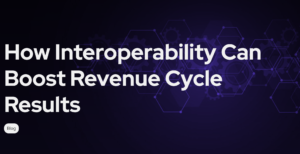Effective healthcare administration requires that healthcare organizations share data with one another in a timely, secure, and accurate way.
APIs and use case-specific data standards—what we currently depend on to achieve interoperability—have been around for years and have done nothing to reduce the friction between payer and providers and other healthcare organizations. And while FHIR and TEFCA have given us a common set of protocols and standards for a payload of transactions on a network, they have done little to improve align the healthcare companies around the common incentives or serving the person and their families in a timely and effective manner.
To achieve effectiveness, speed and quality in healthcare administration we need all the parties involved interconnected and running common processes with common data models in a collaborative fashion that tears down barriers, builds trust, and helps provide better care for patients.
It’s a different processing model that requires a new approach to the administration of healthcare, one focused on collaboration and partnership—not just connections.
In this new collaborative model for the digitally innovative healthcare system, data doesn’t need to be aggregated each time it’s needed. Instead, it would be continuously refreshed, always current, and always accessible in real-time via a secure, peer-to-peer network to those who are permissioned to access it. This type of interoperable communication can completely revolutionize the way healthcare is transacted. Here’s how it might look:
- No need to build and maintain APIs and dedicated connections with each trading partner.
- No need for a third party to validate data or transactions.
- Elimination of the need to aggregate data.
- Transparency in provenance and immutability for BAAs, data use agreements, and other contracts.
- Coverage and other administrative information would always be accessible, refreshed, and current.
- This opens the way for solutions to prior authorizations, quality measure analytics and real-time risk adjustment.
This new way of transacting healthcare isn’t about streamlining the way we currently do things. It’s about doing things completely differently. It’s about reinventing the business of healthcare. I hope this month’s newsletter inspires you to think about interconnection and collaboration beyond interoperability and towards a better way to serve patients and members.
In This Issue
- Digital Transformation Webinar: How Automating the Back Office Delivers Consumer Trust
- Reinventing the Back Office to Finally Deliver on the Patient-Centric Promise
- The Integration Imperative: Achieving a Future Vision for Healthcare
- Who Needs Data Aggregation? There’s a Better Way
- Can Blockchain Solve Healthcare’s Security Problems? The Financial Industry Offers a Valuable Case Study
- How Interoperability Can Boost Revenue Cycle Results
Featured Content
Digital Transformation Webinar: How Automating the Back Office Delivers Consumer Trust
Avaneer Health
We hear a lot about the “digital transformation” of healthcare. But what does that really mean and how do we go about making it a reality? This is the topic of a recent webinar from Avaneer Health, Digital Transformation—How Automating the Back Office Delivers Consumer Trust. Webinar panelists James Carr, Director of Revenue Cycle at Sentara Healthcare and Mark Treshock, Executive Director of Emerging Technology at CVS Health, explore what the digital transformation would look like, what it means in terms of automation, and how it might impact outcomes, costs, and the patient experience. Watch the webinar
Industry News
Reinventing the Back Office to Finally Deliver on the Patient-Centric Promise
MedCity News
We've been talking for years about the importance of creating a better patient experience. Yet, most of us have at least one personal story about a time when inefficient healthcare processes made it difficult to get the care we or a loved one needed. When will healthcare finally deliver on the promise? Read the article
The Integration Imperative: Achieving a Future Vision for Healthcare
Healthcare IT News
Everyone knows that integration is key to achieving interoperability. Yet, many people have a misconception about what is meant by the term “integration.” It’s about more than ensuring systems can talk to each other. This insightful article explores what it means to have an “integration mindset,” especially in four key areas. Read more
Who Needs Data Aggregation? There’s a Better Way
Avaneer Health
For far too long, we’ve focused on fixing our broken system when what we really need is a brand-new way of administering healthcare. We need to look at healthcare through a different lens and we need to do it from the perspective of the patient. After all, healthcare is human, not merely a business process. Read more
Recent research found that the global healthcare blockchain market grew by an annual rate of 55% between 2018 to 2021. The primary drivers were security and a lack of transparency across the value chain.
Can Blockchain Solve Healthcare's Security Problems? The Financial Industry Offers a Valuable Case Study
STAT
Blockchain took the financial industry by storm, but the sector has yet to reap the full rewards of this innovative technology. Now it’s healthcare’s turn. Will healthcare be able to overcome the obstacles that have held other industries back? Only time will tell. Read more
From the Avaneer Blog
 How Interoperability Can Boost Revenue Cycle Results
How Interoperability Can Boost Revenue Cycle Results
Administrative inefficiencies cost the healthcare industry close to $500 billion each year, which includes $39 billion just to comply with administrative regulations and requirements. Advancing administrative interoperability is the only way we will ever reduce the cost of healthcare and achieve long-term revenue improvements. We have to continue asking ourselves what value we could generate if we weren’t spending billions of dollars on administrative waste and how would that enable us to make things better for the patient. Read More
